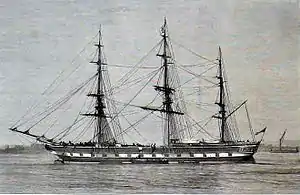Cospatrick (ship)
Cospatrick was a wooden three-masted full-rigged sailing ship that caught fire south of the Cape of Good Hope early on 18 November 1874, while on a voyage from Gravesend, England, to Auckland, New Zealand. Only three of the 472 persons on board survived the disaster, which is often considered the worst in New Zealand's history.[1][2]
 The Cospatrick - The Graphic 9 Jan. 1875 | |
| History | |
|---|---|
| Name: | Cospatrick |
| Acquired: | 1862 by Smith, Fleming & Co. |
| Commissioned: | 1856 |
| Fate: | Destroyed by fire south of Cape of Good Hope in 1874 |
| General characteristics | |
| Class and type: | Blackwall Frigate |
| Tonnage: | 1,199 GRT |
| Length: | 191 ft (58 m) |
| Beam: | 34 ft (10 m) |
| Depth of hold: | 23 ft 6 in (7.2 m) |
| Propulsion: | Sail |
| Sail plan: | full-rigged ship |
| Complement: | 44 |

History
Cospatrick was a Blackwall Frigate built at Moulmein (now Mawlamyaing) in Burma in 1856 for prominent London shipowner Duncan Dunbar. Following Dunbar's death in 1862, the ship was sold to Smith, Fleming & Co. of London. Cospatrick spent most of her career trading between England and India carrying passengers, troops, and cargo. In 1863, Cospatrick was engaged with other ships to lay a telegraphic cable in the Persian Gulf. She had also made two voyages to Australia before being sold to Shaw, Savill & Co. of London in 1873. Cospatrick then became one of many ships owned by this company that carried cargo and emigrants from England to New Zealand.
Destruction
Cospatrick sailed from Gravesend for Auckland on 11 September 1874 with 433 passengers and 44 crew under Captain Alexander Elmslie.[3] The passengers included 429 assisted emigrants, of which 125 were women and 126 were children. During the course of the voyage, eight infants died and one was born (plus another still-birth).[4]
The voyage was otherwise uneventful until about 12.45 a.m. on 18 November - about twelve hours after the vessel's position was determined as 400 miles (640 km) south-west of the Cape of Good Hope.[5] The ship's second mate, Henry Macdonald, later recounted that he had retired at midnight, and was awoken half an hour later by a cry of "Fire!".[1] He hurried onto the deck, and found that a fire had broken out in the boatswain's store, where oakum, tar, paint and ropes were stored. The crew was summoned to man the fire hoses, while the Captain and crew tried, but failed, to turn the ship before the wind, to take the smoke and flames forward and to contain the fire.[3]
The fire rapidly grew out of control and panic ensued. Although there were five lifeboats on board capable of carrying 187 people, only two were successfully launched. These two boats stayed together until the night of 21 November, when one of the boats went missing during a storm. British Sceptre picked up the surviving boat on 27 November, by which time there were only five men left alive; they had been reduced to drinking the blood and eating the livers of their dead companions.[3] They had drifted about 500 miles (800 km) north-east from where Cospatrick had sunk. Two of the survivors died shortly after being rescued.
Aftermath
An inquiry found it most likely that the fire had been caused by members of the crew or passengers broaching cargo in the hold using a naked light, thus igniting the large quantity of flammable cargo including tar, oil, varnish and pitch. Another idea was spontaneous combustion. The lack of lifeboats and inability to launch them successfully at sea also caused public outrage, but little was done until after the loss of the Titanic in 1912.
References
- "Fire on the Cospatrick". Te Ara: The Encyclopedia of New Zealand. Retrieved 12 May 2013.
- "NZ-bound emigrants died on burning ship". Stuff. New Zealand. 2 February 2019.
- Lubbock, Basil (1921). The Colonial Clippers. Kessinger Publishing. pp. 351–354. ISBN 1-4179-6416-2.
- Clark, Charles R. (2006). Women and Children Last - The Burning of the Emigrant Ship Cospatrick. Dunedin, New Zealand: Otago University Press. ISBN 1-877372-14-5.
- "Burning of the Emigrant-Ship Cospatrick at Sea". Illustrated London News. 2 January 1875. Archived from the original on 16 February 2008.